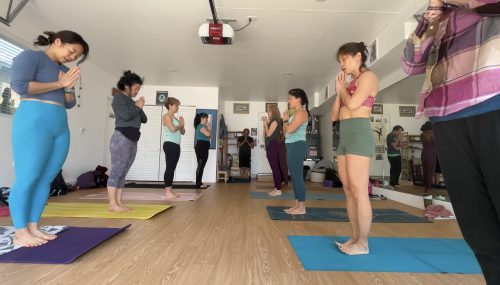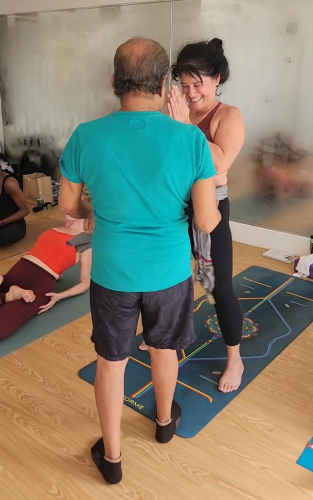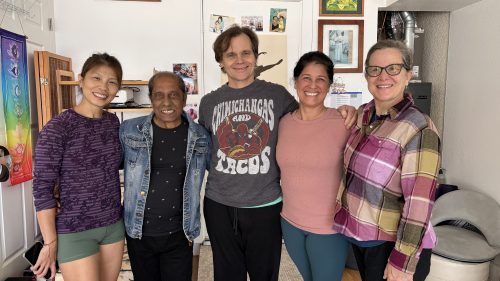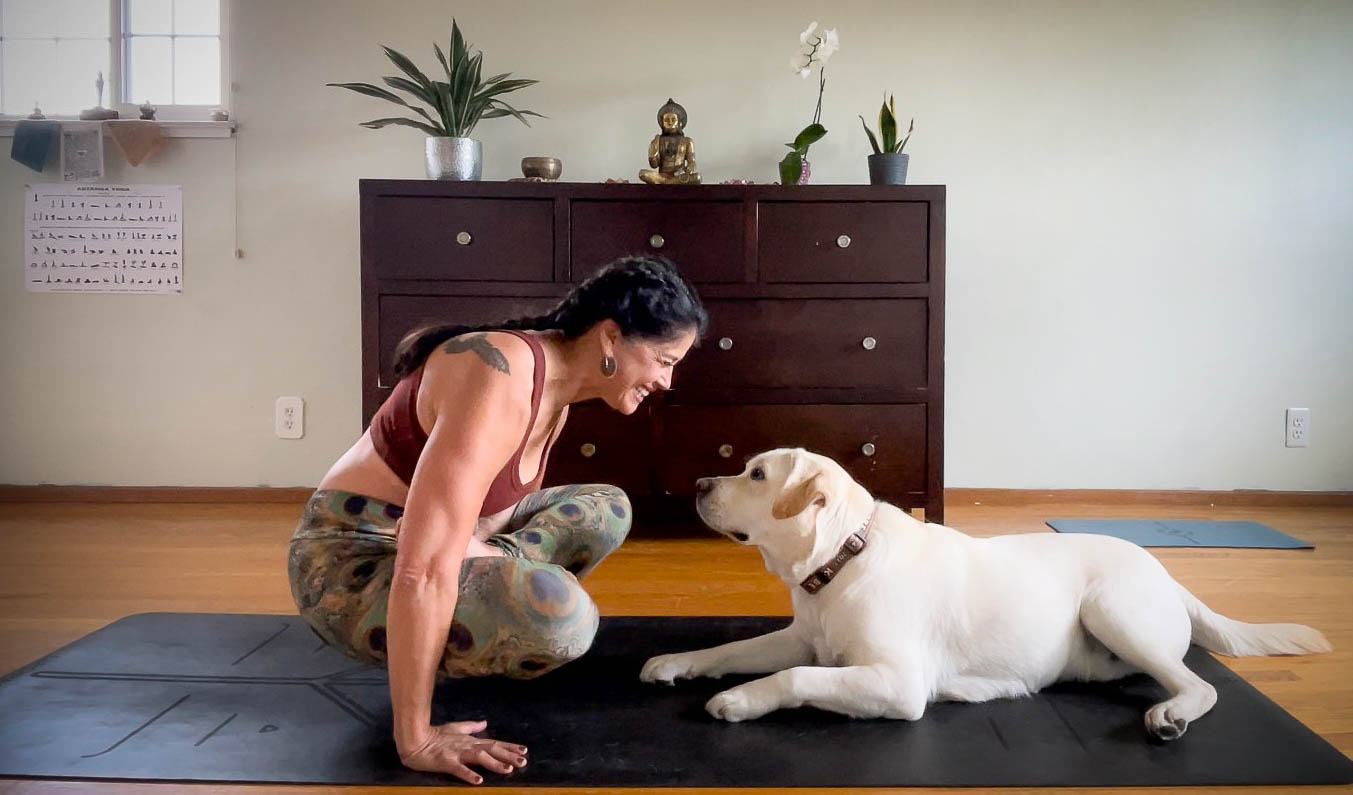energy shifts
The Joy of Acknowledgement
Have you ever noticed how easy it is to see someone else’s progress but how hard it is to recognize your own? As a yoga teacher, I always try to point out the progress I see my students making. It may be something as subtle as a deeper but more relaxed breath — which translates to huge strides down the road. Possibly, it is something more obvious, like being able to balance on their hands in one of the many arm balancing poses.
Believe it or not, the students don’t always seem to acknowledge the progress no matter how obvious it may be. Sometimes, I take a photo to show them the progress I am observing. I did this for one our mysore students this week, pointing out the lovely lines in her trikonasana and utthita parsvokonasana. If they do finally achieve a goal – such as finally getting their foot behind their head in eka pada sirsasana – they are disappointed that they have to hold it in place or it flies off like it’s spring-loaded.
Quite honestly, I am guilty of this myself. Over the last year, my practice has suffered from a number of compounding ailments including finger fractures and shoulder instablity. My focus has been on the struggle to improve but without a lot of notice taken on the steps forward, only the backward shifts that naturally occur in the effort.
Like this new leaf on my monstera plant, new growth is beautiful. Sometimes, these new leaves go unnoticed for a bit as they hide behind the others. But, oh how I love to welcome the newbies into my practice space. They really make me smile.
Back to the topic of yoga: Although somewhat unconsciously, my efforts in not becoming attached to any success have translated to blindfolding me to any progress made in this regard. I think I feared (or maybe expected) that I would lose it again in the next days, weeks, or months. There’s been a lot of that.
In the beginning, this may have been thought to be non-attachment but I now think that the failure to celebrate the successes has lead to less joy in my yoga practice. And I really need JOY right now. I mean, in addition to the joy of seeing new leaves on my plants.
For this reason, I plan to resurect the habit of daily entries in my yoga journal in the month of May with a focus on listing out some wins each day. In the past, regular journalling about my yoga practice has served as a nice way to highlight emerging injuries and track them back seemingly subtle to modifications or added poses. This month, I hope to be able to pay a bit more attention to little steps of progress as well as the coming and going of poses as I continue to work on healing from the injuries of the past year. Currently, I am calling this exercise the Joy of Acknowledgement.
I invite you to do the same and/or share your thoughts in the comments section of this post.
Okay Enough
As the date got closer to my longtime plans to return to practice with Manju Jois and Greg Tebb at the No Stress Shala (aka Manju’s garage), I became apprehensive about going. Although we are taught not to judge our practice as good or bad, I find myself disappointed in the limitations of my body more often than not. In truth, Manju doesn’t care what my practice looks like. He is there to provide a supportive environment for therapeutic yoga. If anything, I really should have been thinking of going to see Manju as a MUST. I have just been a bit stuck.
 All of the ailments of 2023, (the right shoulder, elbow & finger, left hip, and SI joint) had been improving. I had dedicated a lot of time and resources to the recovery and stablization efforts. As a result, I was having to modify a lot less often than before. Still, I was apprehensive. Of course, there was no need to be worried.
All of the ailments of 2023, (the right shoulder, elbow & finger, left hip, and SI joint) had been improving. I had dedicated a lot of time and resources to the recovery and stablization efforts. As a result, I was having to modify a lot less often than before. Still, I was apprehensive. Of course, there was no need to be worried.
After our first night at the Comfort Inn (previously the Quality Inn), Eva deemed the accomodations as “okay enough”. We each had a bed, the rooms each had a locking door, and we might not have even known that the sheriff was paying a visit to the room a few doors down from us if we hadn’t left while they were there. The term “okay enough” would be brought up many times during the week — keeping us light hearted and amused. And I would walk into the “no stress shala” with the notion that my asana practice was indeed “okay enough”.
The thing is, once I shifted to being “okay enough”, all my judgement melted away. If I messed up, I laughed at myself. I allowed others to encourage and compliment me without second-guessing. I had fun and let the Manju magic do it’s thing.
The week went by way too fast. Our days at the shala were filled with asana practice, followed by pranyama, chanting, and yummy home-cooked vegetarian meals. We learned new ways to assist others’ in many different asanas.
During the rest of the time in lovely Encinitas, CA. we:
- drank LOTS of coffee,
- laughed a whole lot,
- hiked,
- visited Eva’s handstand coach,
- saw the sea lions in San Diego,
- window-shopped & people-watched,
- basked in the sun,
- wadded through large puddles of rain,
- and ate and ate and ate (even dessert, thanks to Shelly’s encouragement).
All in all, the trip was just what I needed. It was “okay enough” and so much more, of course.
Contentment
Although the focus of my yoga practice may appear to be on the physical asanas of the practice, there is a deeper, more spiritual, level to the practice. The Ashtanga Yoga system is built upon the “Eight Limbs of Yoga.” (the word ‘ashta’ means ‘eight’ and ‘anga’ means ‘limb’). When I first began my yoga practice, it was very much about the shapes of the asanas. But, over time, the philosophical and spiritual components began taking precidence over the shapes. That said, it is very easy to lose sight over the reason for the practice. As I age and my body’s ability to perform the physical asanas as well, or as easily, as I once did, the 2nd Niyama becomes more an more important.
“Samtosha, or contentment, is a pure and exellent form of happiness that spontaneously arises when we free ourselves from the mind’s constant nagging about unfullfilled desires. This is really the secret to moving on with our lives rather than being stuck in and trapped by a specific situation. Samtosha arises when the mind lets go of its iron grip of a situation long enough to let us simply observe with great interest but without drawing conclusions or making judgments and assumptions. Letting go, we automattically tap into an endless reservoir of kindness and compassion that lies within.” – The Art of Vinyasa; Awakening Body and Mind through the Practice of Ashtanya Yoga by Richard Freeman & Mary Taylor.
This past weekend, I awoke feeling a constant ache and soreness from an 8 mile, hilly trail run. Adding insult to injury, so-to-speak, it was raining and dark outside. I should just go back to sleep, I thought, my practice won’t be any good anyway. Pushing that aside, I decided to show up for my yoga practice anyway. I would do what I could and try to be satisfied with whatever that was.
What’s new?
I’ve been struggling to produce a unique response to the yoga studio’s prompt for the teacher spotlight for Spring. The prompt, “What’s new in your practice?” seems like a simple question. So, why am I three weeks late on coming up with a response?
The simple answer is nothing. I have not been given any new poses for over 6 months. I have been showing up for class faithfully since the beginning of the pandemic — even when I knew that being on camera would mean that my broken heart would be seen by all. The practice has it’s way of revealing the raw parts on us, whether we like it or not.
But, it’s not that simple. As the anniversary of my husband’s passing, Spring spotlights the deepest, saddest parts of me. I don’t go looking for these feelings, they bubble up regardless of attention. Trying to distract myself from it is like ignoring an injury (such as a broken toe) while practicing yoga; the pain makes you take notice.
Instead of going about my every day activities, I’ve made point of giving myself the space to feel what ever comes up during this time. In past years, my answers to the Spring teacher prompts were bathed in a melancholy of sorts. I didn’t want to repeat that this time. Instead, I asked for more time.
Additionally, I took time off from work and asked another teacher to sub for me on the anniversary day so that I could have my yoga practice at the usual morning time.
Interestingly, my asking for more time, as well as getting coverage for my class, is exactly the thing that is new for me.
I’ve spent my life giving to others — sometimes at my own expense. Lately, however, it’s taking a toll on me. My body is unhappy and my mind frazzled trying to be in two places at once and please everyone — all with the expression on my face on display for all to see. As the pandemic wears on, I have come to realize that I just can’t do it all.
On my mat, I pull my attention back to myself, the prescribed dristhi, and the sound of my own breath (instead of the computer). I have also been more conscious of conserving my energy when it is low. After all, this is the practice as it was meant to be done.
Yet, during the past couple of years, I have found myself grasping to contribute and hold space for a community-feel amidst the pandemic-driven online environment. While this sounds like a good thing, it has it’s drawbacks for both me as well as for the members of my yoga community. It’s time to zip my lips and continue to contribute simply by showing up for practice. And if we want to chat it up, well perhaps there will be time for that too (outside of practice, that is).
Living Out Loud
Just over 2 years ago, my yoga teacher sat down beside me on my mat to have a heart-to-heart with me. She is a very intuitive and caring person and saw that I was closing off. The backbends that I had worked so hard to develop where losing their beautiful arch and you could see that I was holding back. She wanted to help me find openness in my heart center, not just in my physical backbends but deep within. As much as I trusted her to hold space for me to do the work, I also knew that the timing just wasn’t right. I was working through a huge heartbreak and felt the need to protect my heart.
In the year that followed, she held space for me to work through it. If I broke down in tears after back bending, she didn’t make a big deal out of it. Because if emotions come up in this practice and our mat is a safe place for us to work through it. Within the Mysore Room of my yoga studio, I felt safe to let the sadness, anger, frustration, and other emotions go right there on my mat, with my fellow practitioners nearby. Meanwhile, my teacher continued her work in the room, helping the students just as before. I appreciated that.
By the time COVID-19 had us all staying within the walls of our homes, an entire year had passed. And although, I thought I’d be on the other side of the loss by then, sheltering-in-place uncovered a different level of pain for me. A pain that showed up on my computer screen in an in-your-face, take-THIS sort of way. At times, I felt as if all the work I had done was a lie; I felt those protective walls thickening and my heart closing off once again.
As the months passed, it was evident that if was to ever be freed from the fortress of protection that I had built around me, I had much more work to do. Read More



